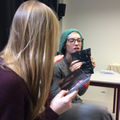User:Emily/Thematic Project/Trimester 02/04
Intro to physical book
This book was produced using images and texts (subtitles) taken from the Roman Polanski's film, “The Tenant”. The images and texts are extracted at moments when characters say the word "know", and then the frames and texts are reassembled into the form of book. Some of the pages are designed to be shorter than the rest, which provides the opportunity for the reader to read across pages, and at different intervals.
“The Tenant” is a psychological horror film directed by Roman Polanski. The main character, Trelkovsky, is confronted by a mental conflict after he moves into the new apartment. The relationships among himself and the other neighbours become weird. He undergoes a transformation, and becomes the previous tenant. In the end, he dresses up again as a woman and throws himself out the apartment window in the manner of the previous tenant, Simone. He ends up bandaged in the same fashion as Simone, in the same hospital bed. But ultimately we see Trelkovsky and Simone's close friend Stella visiting Simone in the hospital.
I was obsessed by the whole transposing from one person’s life onto another and the mutative relationships among the main charater and other tenants that we see through out the story. These transformations triggered the production of my book. Sampling all incidents through out the story, I juxtaposed all the dialogues containing the word "know". Each sentence that was extracted from the script became my re-constructed narration, and altered the perception of events. An external way of reading the film is presented in this book with all the existing images and texts.
Digital Book
From the fiction book The Life and Opinions of the Tomcat Murr(1819-1821) by E.T.A. Hoffmann to Dadaist poet Tristan Tzara, and to the game of Exquisite Corpse developed by Surrealists writers, then to experimental literature group Oulipo, later on to William S. Burroughs and Brion Gysin, the works from all of these writers and artists showed the power of cut-ups and the fantasy from arbitrary juxtaposition. I found it is exactly what interests me most for now. In digital age, to all netizens cut-ups exist in everyday life, we receive more fragments, and alway be multitasking jumping one quickly to another. "we no longer watch films and TV, we watch databases" And the juxtaposition is no longer arbitrary. Our data get traced, we are feed by all those recommendations. But what I want to research more is not all these commercial strategies. But "to study online video is to study this intimate aspect of affect, no the theories of commercial repackaging that underlie common rhetoric about remediation." (Networks without A Cause, Geert Lovink) "The social is the core constitutive element of contemporary video practice and not some leftover redundant noise surrounding audiovisual content." So I am questioning myself what will affect people most in the database watching? This is also the topic of my self-directed research, which already got started from last Thematic Project (please refer to my mock-up kickstart project).
For this digital book project, I am following the way of how the game of Exquisite Corpse developed. At initial time, the game requires several people involved to compose a sentence without knowing what words have been written down. Several years later, a question-and-answer varian on the Exquisite Corpse produced a curiously resonant definition:"What is André Breton? An amalgam of humour and a sense of disaster; something like a top hat." I was fascinated by this tasteful sentence/question and answer. So I use the video clips contain questions from the film The Tenant when characters say "know" within a question and put them on the left side of my webpage. I also extract possible answers from the subtile putting them accordingly on the right side of my webpage. By scrolling the page viewer can scan each clip, only when scrolling to some certain places, the clips of questions will play and the texts of answers will be shown.
By putting the existing material in different context, new connections can be made by the viewers.










